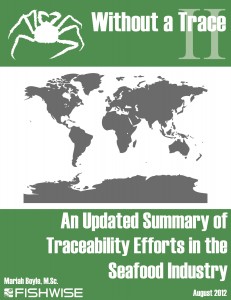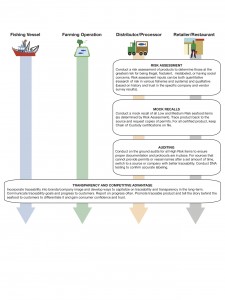Without a Trace…
 It’s officially here! All my hard work this summer has come together in one report that was printed and announced yesterday! Without a Trace II: An Updated Summary of Traceability Efforts in the Seafood Industry can be downloaded using that link or on this page.
It’s officially here! All my hard work this summer has come together in one report that was printed and announced yesterday! Without a Trace II: An Updated Summary of Traceability Efforts in the Seafood Industry can be downloaded using that link or on this page.
It’s an expanded (50 pages, to be exact) version of the original report, that summarizes everything from the history of seafood traceability, to the laws and international agreements that pertain to traceability, to why seafood traceability is so important in the first place. It also has a long list of seafood certification companies, traceability companies, DNA testing companies, nonprofits and industry groups that work in seafood traceability, with summaries about what each group is working on. There’s a list of all the current IUU blacklists, as well as pages of useful links, references and contact information for all of the organizations mentioned. The paper wraps up with suggested next steps for both seafood business and the traceability movement as a whole.
So why is seafood traceability so important?

Supply Chain including subsistence fishing, wild capture fisheries, aquaculture, recreation fishing and processing & distribution.
Historically seafood traceability was important for food safety, specifically being able to trace back food-borne illness outbreaks to the origin. Now, it’s also important for cases of fraud, as mislabeling rates can be as high as 60%, depending on the region and type of fish. IUU fishing is a global problem, with economic losses from $10-23.5 billion, which represents 11-26 million tons of seafood a year. The illegal fishing industry is also rife with human rights violations, due to the lack of transparency and accountability. Traceability assures that the seafood you’re eating was not sourced illegally, and is free of human rights violations. In addition, traceability can help prove the sustainability of the system as well as be a marketing tool for knowledgeable consumers.
The case for traceability is growing and gaining momentum every day. While the challenges to setting up 100% traceable supply chains are major–geography, technology, business being the biggest areas–the rewards are great, and the industry is heading that direction. This paper is a great resource for those interested in seafood traceability, industry members and those looking for next steps in their business.
The two pages below are the different recommendations for different sectors of the fishing industry, including fishing vessels, aquaculture, processing & distribution, and retailers & restaurants.
Tags: CBE, FishWise, seafood, summer
This entry was posted on Thursday, August 30th, 2012 at 9:24 pm and is filed under CBE, MIIS. You can follow any responses to this entry through the RSS 2.0 feed. Responses are currently closed, but you can trackback from your own site.
Comments are closed.




